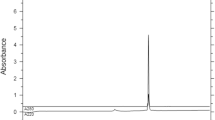Abstract
Mutter’s pseudoproline dipeptides and Sheppard’s Hmb derivatives are powerful tools for enhancing synthetic efficiency in Fmoc SPPS. They work by exploiting the natural propensity of N-alkyl amino acids to disrupt the formation of the secondary structures during peptide assembly. Their use results in better and more predictable acylation and deprotection kinetics, enhanced reaction rates, and improved yields of crude products. However, these approaches have certain limitations: pseudoproline dipeptides can only be used for sequences containing serine or threonine, and the coupling of the amino acid following the Hmb residue can be extremely difficult. To alleviate some of these shortcomings, we have prepared a range of Fmoc-Aaa-(Dmb)Gly-OH dipeptides and tested their efficacy in the synthesis of a number of challenging hydrophobic peptides. We also compared the efficiency of N-Dmb against N-Hmb backbone protection in preventing aspartimide formation in the Fmoc SPPS of peptides containing the Asp-Gly sequence.







Similar content being viewed by others
References
Abedini A, Raleigh DP (2005) Incorporation of Pseudoproline derivatives allows the facile synthesis of human IAPP, a highly amyloidogenic and aggregation-prone polypeptide. Org Lett 7:693–696
Bayer E (1991) Towards the chemical synthesis of proteins. Angew Chem Int Ed Engl 30:113–129
Bedford J, Carolyn BH, Johnson T, Jun W, Quibell M, Robert CS (1992) Amino acid structure and difficult sequences in solid phase peptide synthesis. Int J Pept Protein Res 40:300–307
Haack T, Mutter M (1992) Serine derived oxazolidines as secondary structure disrupting, solubilizing building blocks in peptide synthesis. Tetrahedron Lett 33:1589–1592
Hyde C, Johnson T, Owen D, Quibell M, Sheppard RC (1994) Some difficult sequences made easy—a study of interchain association in solid-phase peptide-synthesis. Int J Pept Protein Res 43:431–440
Jobling MF, Barrow CJ, White AR, Masters CL, Collins SJ, Cappai R (1999) The synthesis and spectroscopic analysis of the neurotoxic prion peptide 106–126: comparative use of manual Boc and Fmoc chemistry. Lett Pept Sci 6:129–134
Johnson T, Quibell M, Owen D, Sheppard RC (1993) A reversible protecting group for the amide bond in peptides: use in the synthesis of difficult sequences. J Chem Soc Chem Commun 369–372
Kent SBH (1988) Chemical Synthesis of Peptides and Proteins. Annu Rev Biochem 57:957–989
Mergler M, Dick F, Sax B, Weiler P, Vorherr T (2003) The aspartimide problem in Fmoc-based SPPS: part 1. J Pept Sci 9:36–46
Milton RCD, Milton SCF, Adams PA (1990) Prediction of difficult sequences in solid-phase peptide synthesis. J Am Chem Soc 112:6039–6046
Narita M, Fukunaga T, Wakabayashi A, Ishikawa K, Nakano H (1984) Syntheses and properties of tertiary peptide-bond-containing polypeptides. Int J Pept Protein Res 23:306–314
Nicolas E, Pujades M, Bacardit J, Giralt E, Albericio F (1997) A new approach to Hmb-backbone protection of peptides: synthesis and reactivity of N-alpha-Fmoc-N-alpha-(Hmb) amino acids. Tetrahedron Lett 38:2317–2320
Oliveira E, Miranda A, Albericio F, Andreu D, Paiva ACM, Nakaie CR, Tominaga M (1997) Comparative evaluation of the synthesis and purification of transmembrane peptide fragments–rat bradykinin receptor fragment 64–97 as model. J Pept Res 49:300–307
Packman LC, Quibell M, Johnson T (1994) Roles of electrospray mass-spectrometry, counterion distribution monitoring and N-(2-Hydroxy-4-Methoxybenzyl) backbone protection in peptide-synthesis. Pept Res 7:125–131
Quibell M, Owen D, Packman LC, Johnson T (1994) Suppression of piperidine-mediated side product formation for Asp(OtBu)-containing peptides by the use of N-(2-Hydroxy-4-Methoxybenzyl) (Hmb) backbone amide protection. J Chem Soc Chem Commun 2343–2344
Sampson WR, Patsiouras H, Ede NJ (1999) The synthesis of ‘Difficult’ peptides using 2-Hydroxy-4-methoxybenzyl or pseudoproline amino acid building blocks: a comparative study. J Pept Sci 5:403–409
Schnölzer M, Alewood P, Jones A, Alewood D, Kent SBH (1992) In situ neutralization in Boc-chemistry solid phase peptide synthesis. Rapid, high yield assembly of difficult sequences. Int J Pept Protein Res 40:180–193
Simmonds RG (1996) Use of the Hmb backbone-protecting group in the synthesis of difficult sequences. Int J Pept Protein Res 47:36–41
Stewart JM, Klis WA (1990) Polystyrene-based solid phase peptide synthesis: the state-of-the-art. In: Epton E (ed) Innovations and perspectives in solid phase synthesis: peptides, polypeptides and oligonucleotides. SPCC (UK) Ltd, Birmingham, pp 1–9
Tagliavini F, Prelli F, Verga L et al (1993) Synthetic peptides homologous to prion protein residues 106–147 form amyloid-like fibrils in vitro. Proc Natl Acad Sci USA 90:9678–9682
Toniolo C, Bonora GM, Mutter M, Pillaib VNR (1981) linear oligopeptides, 77a) the effect of the insertion of a proline residue on the solid-state conformation of host peptides. Makromol Chem 182:1997–2005
Weygand F, Steglich W, Bjarnason J, Akhtar R, Khan M (1966) Leicht abspaltbare schutzgruppen für säureamidfunktionen 1 Mitteilung. Tetrahedron Lett 7:3483–3487
White PD, Keyte J, Bailey K, Bloomberg G (2004) Expediting the Fmoc solid phase synthesis of long peptides through the application of dimethyloxazolidine dipeptides. J Pept Sci 10:18–26
Zahariev S, Guarnaccia C, Pongor CI, Quaroni L, Cemazar M, Pongor S (2007) Application of peptoid methodology for synthesis of “Difficult” peptides free of aspartimide and related products. In: Rolka K, Rekowski P, Silberring J (eds) Peptides 2006, Proceedings of the European Peptide Symposium. Kennes International, Geneva, pp 84–85
Zhang L, Goldammer C, Henkel B, Zuehl F, Panhaus G, Jung G, Bayer E (1994) “Magic Mixture”, a powerful solvent system for solid-phase synthesis of “difficult sequences”. In: Epton E (ed) Innovation and perspectives in solid phase synthesis: peptides, proteins and nucleic acids—biological and biomedical applications, 3rd International Symposium. Mayflower Worldwide Ltd., Birmingham, UK, pp 711–716
Author information
Authors and Affiliations
Corresponding author
Rights and permissions
About this article
Cite this article
Cardona, V., Eberle, I., Barthélémy, S. et al. Application of Dmb-Dipeptides in the Fmoc SPPS of Difficult and Aspartimide-Prone Sequences. Int J Pept Res Ther 14, 285–292 (2008). https://doi.org/10.1007/s10989-008-9154-z
Received:
Accepted:
Published:
Issue Date:
DOI: https://doi.org/10.1007/s10989-008-9154-z




